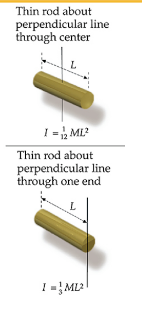1. A satellite is spinning at 6 rev/s. The satellite consists of a main body in the shape of a sphere of radius 3 m and a mass of 300 kg, and two antennas projecting out from the surface of the main body that can be approximated with rods of length 4 m each and mass 10 kg. The antennas lie in the plane of rotation. See the figure below. M, L Ms R M₁L Things to think about: 1. The system is made of one sphere and two rods attached to the surface of the sphere. The total moment of inertia of the system is the sum of individual moments of inertia. 2. The axis of rotation for the system is about the center of the sphere. How can you calculate the moment of inetia of the rods about this axis? How far are the center of mass of the rods away from the axis of rotation? 3. What is the moment of inertia of a rod about an axis through the center of the rod? (a) Calculate the total moment of intertia of the system about an axis passing through the center of the sphere. Itotal kg m² (b) What is the magnitude of the angular momentum of the satellite? L= 22368.139 kg m²/s
Angular Momentum
The momentum of an object is given by multiplying its mass and velocity. Momentum is a property of any object that moves with mass. The only difference between angular momentum and linear momentum is that angular momentum deals with moving or spinning objects. A moving particle's linear momentum can be thought of as a measure of its linear motion. The force is proportional to the rate of change of linear momentum. Angular momentum is always directly proportional to mass. In rotational motion, the concept of angular momentum is often used. Since it is a conserved quantity—the total angular momentum of a closed system remains constant—it is a significant quantity in physics. To understand the concept of angular momentum first we need to understand a rigid body and its movement, a position vector that is used to specify the position of particles in space. A rigid body possesses motion it may be linear or rotational. Rotational motion plays important role in angular momentum.
Moment of a Force
The idea of moments is an important concept in physics. It arises from the fact that distance often plays an important part in the interaction of, or in determining the impact of forces on bodies. Moments are often described by their order [first, second, or higher order] based on the power to which the distance has to be raised to understand the phenomenon. Of particular note are the second-order moment of mass (Moment of Inertia) and moments of force.
How do we solve for (a) and (b)?

Trending now
This is a popular solution!
Step by step
Solved in 2 steps with 2 images

When entering the values the answer shows as wrong, would it be that we use 1/12 ML^2 insted of 1/3 ML^2 for inertia of rod?









